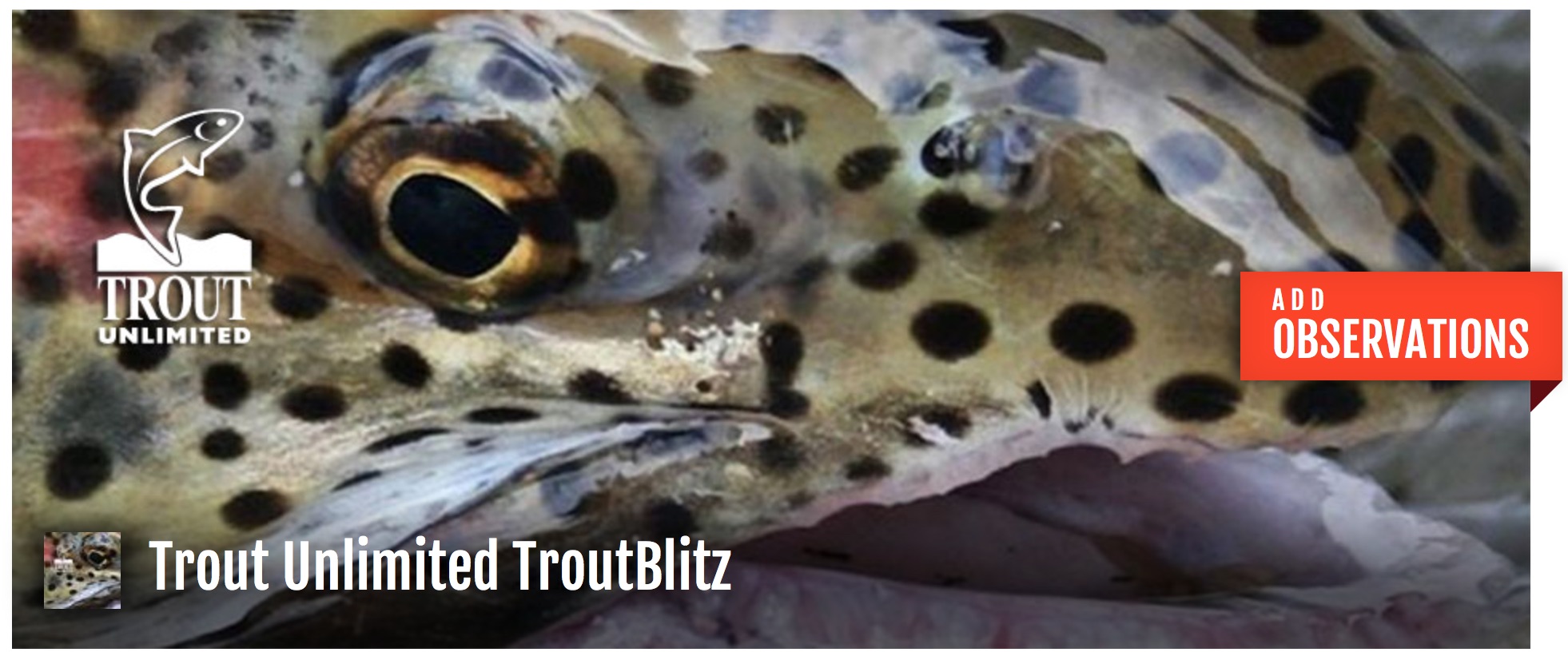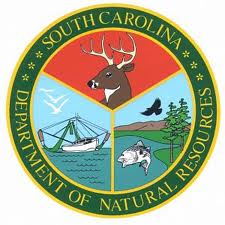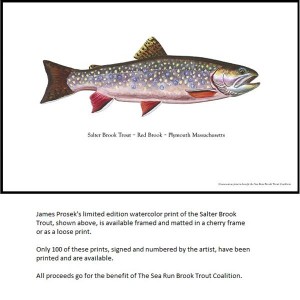 If you’re out there catching native trout then you may be interested in contributing photos and data to TroutBlitz, Trout Unlimited’s initiative to catalog North America’s salmonids. It’s based on the concept of a BioBlitz, but instead of just 24 hours this is an ongoing effort. Use this guide to help you do it correctly. They have apps for iOS and Android, too (see the main TroutBlitz page, links at the bottom). And if you’re looking for new places to find fish, this is another good resource.
If you’re out there catching native trout then you may be interested in contributing photos and data to TroutBlitz, Trout Unlimited’s initiative to catalog North America’s salmonids. It’s based on the concept of a BioBlitz, but instead of just 24 hours this is an ongoing effort. Use this guide to help you do it correctly. They have apps for iOS and Android, too (see the main TroutBlitz page, links at the bottom). And if you’re looking for new places to find fish, this is another good resource.
Trout Unlimited
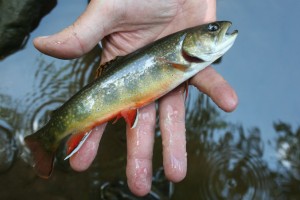
What, a new post???!!! I know, it’s been a while…
Good article on the Trout Unlimited blog about protecting brook trout in the Appalachians. Good news and bad news about the future of the only native trout in the eastern U.S.
Related article about Thorn Creek that is also interesting.
From the Field: Linking land and water in brook trout conservation from Chesapeake Bay Program on Vimeo.
 The Sea Run Brook Trout Coalition is doing a membership drive right now. Sign up for an annual membership and you’ll automatically be entered into a drawing to win a James Prosek salter print. As you may know, the SRBTC is fighting to restore habitat for wild sea-run brook trout in southeastern Massachusetts and other parts of coastal New England where this sub-species of brook trout is hanging on.
The Sea Run Brook Trout Coalition is doing a membership drive right now. Sign up for an annual membership and you’ll automatically be entered into a drawing to win a James Prosek salter print. As you may know, the SRBTC is fighting to restore habitat for wild sea-run brook trout in southeastern Massachusetts and other parts of coastal New England where this sub-species of brook trout is hanging on.
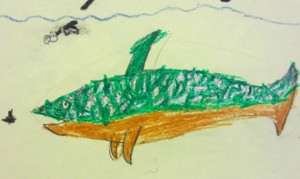 Students from Wildwood Middle School in Shenandoah Junction, West Virginia are looking into the possibility of reintroducing brook trout to the panhandle of West Virginia. Brook trout were extirpated from the eastern panhandle of the state some time ago (trying to find out exactly when is typically difficult) due to development and habitat loss, the usual stuff. However, it appears that some streams and forests have come back enough to at least make the study of reintroduction worthwhile.
Students from Wildwood Middle School in Shenandoah Junction, West Virginia are looking into the possibility of reintroducing brook trout to the panhandle of West Virginia. Brook trout were extirpated from the eastern panhandle of the state some time ago (trying to find out exactly when is typically difficult) due to development and habitat loss, the usual stuff. However, it appears that some streams and forests have come back enough to at least make the study of reintroduction worthwhile.
This program has some strong local support from people like Kelly’s White Fly Shop in Shepherdstown, WV, the Winchester Virginia Trout Unlimited chapter, local guide and fly casting instructor Dusty Wissmath, and others.
You can follow their progress on the Wildwood Middle School blog.
I missed this story last month about the South Carolina Department of Natural Resources restoring eastern brook trout in mountain streams in the Jocassee Gorges area. Great account of how the state government, Duke Energy and a group of conservation organizations are working together to make this happen.
“‘There is a big hole there,’ [Dan Rankin, fisheries biologist with the SC DNR] said, ‘where brook trout should be, but they’re not.’
“Rankin thinks that forest management practices of the early 1900s, when timber companies did not abide by Best Management Practices that are now in place to protect water and soil, contributed to the absence of brook trout in the region. But whatever the cause, Rankin and a coalition of government agencies and private conservation organizations are working to bring the Eastern brook trout back to the mountain streams that it historically inhabited in the Jocassee Gorges.”
And it all concludes with a sordid tale of woolly adelgids murdering hemlocks, which were then used to create better habitat for the fish. A must read!
Just got notified that the Sea Run Brook Trout Coalition in Massachusetts is accepting dues and payment for limited edition artwork on their website:
Hi Folks, The Sea Run Brook Trout Coalition website is now set up to accept Paypal for annual dues and sales of the limited addition James Prosek print of the Red Brook salter. Please visit the SRBTC website for more information.
They also indicate on their website that they are “actively seeking sponsors and members.” It’s a good cause if you are interested in conserving this wonderful strain of brook trout, which run to and from the ocean and get quite large for brookies.
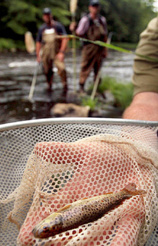 Some controversy is brewing in West Virginia over Trout Unlimited’s recent directive. You can read it here and it basically instructs members not to participate in stocking hatchery-raised trout in streams that are inhabited by native brook trout or fed by other streams containing brook trout. This is causing a stir in the Mountaineer State. Local TU leaders as well as the West Virginia Department of Natural Resources are not keen on being told how to manage their fisheries and are feeling little urge to comply.
Some controversy is brewing in West Virginia over Trout Unlimited’s recent directive. You can read it here and it basically instructs members not to participate in stocking hatchery-raised trout in streams that are inhabited by native brook trout or fed by other streams containing brook trout. This is causing a stir in the Mountaineer State. Local TU leaders as well as the West Virginia Department of Natural Resources are not keen on being told how to manage their fisheries and are feeling little urge to comply.
“Regardless of what National TU does, we’ll continue managing our fisheries in the way we think benefits our anglers the most,” said Mike Shingleton, leader of the DNR’s Trout Program. “They aren’t going to tell us how to run our trout program.”
My own opinion — that of an outsider with a soft spot for conservation of brook trout — is in agreement in principle with TU’s directive. However, I am not familiar with the specifics of trout stocking programs in West Virginia, the overall health of brook trout populations in the state, the history of fisheries management there, and I’m not a biologist, environmental policy person or a freaking politician. This may in fact be a blunder by TU and the concerns it addresses may or may not merit this policy. The article linked above brings up a lot of good points and certainly brings to light the perspective of the folks in the state.
I have written about my own views regarding stocking trout downstream of brook trout populations in Virginia, specifically in Shenandoah National Park and specifically about the obligation to kill any brown trout caught there. The science behind these practices shows that brook trout populations are definitely affected (even more details found at TU’s conservation success index site).
I know people want to take fish home, and stocked trout are a great resource for those folks. Likewise, there are trout streams containing brook trout that will not support them further downstream, year-round, etc. and most of us certainly enjoy going after browns and rainbows in the winter while the brookies spawn. If the details of TU’s edict are overly broad it may be overkill. Like I said I don’t know all the details but striking the right balance to accomodate all the interests involved is getting messy and I fear this kind of conflict is going to become more common around the country.
The salters? Yes, the saltaahs! An update from Orvis News about efforts to restore sea going brook trout (aka. “salters” that’s right) on Red Brook, a 4.5 mile spring creek that feeds into Buttermilk Bay on Cape Cod, Massachusetts.
The Sea Run Brook Trout Coalition as well as Trout Unlimited are leading this effort. These sea run native brookies are hanging on thanks to these organizations.
Good stuff.
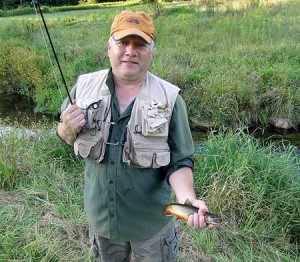
Via the Pierce County Herald, a success story about thriving brook trout in the restored Pine Creek in Wisconsin.
I love reading stores like this.
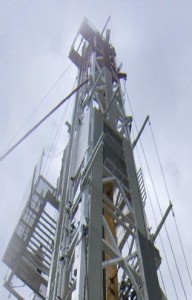
Just received an email from Trout Unlimited mentioning a group I was not familiar with, the Sportsmen Alliance for Marcellus Conservation. They have a video about the concerns associated with gas drilling in Pennsylvania and you can also listen to a recent podcast about the Sportsmen Alliance with Chris Wood, TU’s CEO, and Katy Dunlap, Director of the TU’s Eastern Water Project.
I think their focus is well-stated:
“The Sportsmen Alliance for Marcellus Conservation (Sportsmen Alliance) is a coalition of sportsmen and women working together to identify and propose solutions to mitigate the impacts caused by gas drilling in the Marcellus Shale on hunting, fishing, trapping and other outdoor sporting activities. The coalition is not opposed to gas drilling and recognizes the potential economic and social benefits. Rather, the Sportsmen Alliance is concerned that the current state and local policies governing gas drilling and hydraulic fracturing in the Marcellus Shale do not adequately protect valuable and irreplaceable natural resources, including clean water and critical habitat for fish and wildlife.”
You can also read more about the Sportsmen Alliance in an article from the Wall Street Journal. Some troubling things the group has found include the following:
“Already, preliminary water testing by sportsmen is showing consistently high levels of bromides and total dissolved solids in some streams near fracking operations, Dufalla said. Bromide is a salt that reacts with the chlorine disinfectants used by drinking water systems and creates trihalomethanes.”
Keeping on top of how energy companies extract natural gas is critical. There is no good way to clean up contaminated ground water and we certainly want to avoid contaminating streams and drinking water supplies near these drilling operations. I’ve written about the dangers of gas drilling in the Marcellus Shale region quite a bit previously. The threat to brook trout streams is real.
